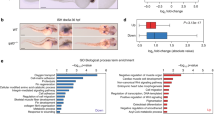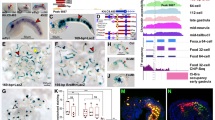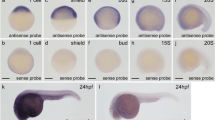Abstract
The PEA3 subfamily of ETS-domain proteins play important roles in regulating transcriptional activation and have been implicated in several tumorigenic processes. Here we describe the identification of a further member of this family from zebrafish which most likely represents a homologue of PEA3. A high degree of sequence conservation is observed in the ETS DNA-binding domain and acidic transcriptional activation domain. The DNA binding specificity of zebrafish PEA3 is virtually identical to that exhibited by mammalian family members and is autoregulated by cisacting inhibitory domains. Transcriptional activation by zebrafish PEA3 is potentiated by the ERK MAP kinase and protein kinase A pathways. During embryogenesis, PEA3 is expressed in complex spatial and temporal patterns in both mesodermal somites and ectodermal tissues including the brain, dorsal spinal chord and neural crest. Our characterisation of zebrafish PEA3 furthers our understanding of its molecular function and its expression profile suggests a novel role in cell patterning in the early vertebrate embryo.
This is a preview of subscription content, access via your institution
Access options
Subscribe to this journal
Receive 50 print issues and online access
$259.00 per year
only $5.18 per issue
Buy this article
- Purchase on Springer Link
- Instant access to full article PDF
Prices may be subject to local taxes which are calculated during checkout
Similar content being viewed by others
Author information
Authors and Affiliations
Rights and permissions
About this article
Cite this article
Brown, L., Amores, A., Schilling, T. et al. Molecular characterization of the zebrafish PEA3 ETS-domain transcription factor. Oncogene 17, 93–104 (1998). https://doi.org/10.1038/sj.onc.1201911
Received:
Revised:
Accepted:
Published:
Issue Date:
DOI: https://doi.org/10.1038/sj.onc.1201911
Keywords
This article is cited by
-
PEA3/ETV4-related transcription factors coupled with active ERK signalling are associated with poor prognosis in gastric adenocarcinoma
British Journal of Cancer (2011)
-
Expression and function of the Ets transcription factor pea3 during formation of zebrafish pronephros
Pediatric Nephrology (2011)
-
Characterization of the human and mouse ETV1/ER81 transcription factor genes: role of the two alternatively spliced isoforms in the human
Oncogene (1999)
-
Molecular characterization of a zebrafish TCF ETS-domain transcription factor
Oncogene (1999)



